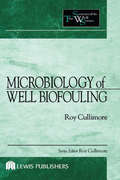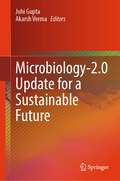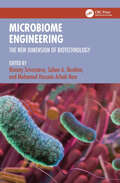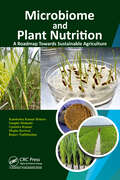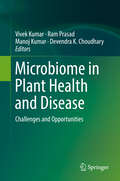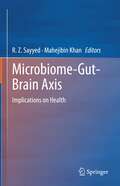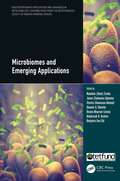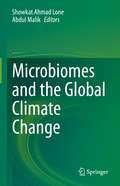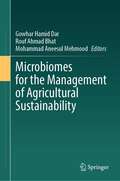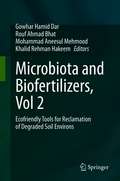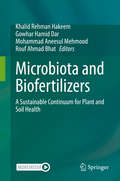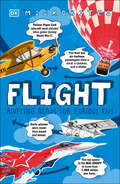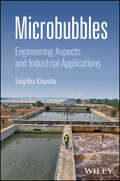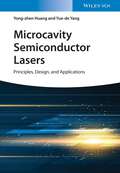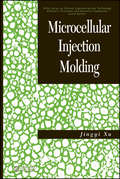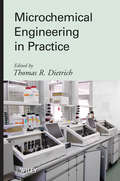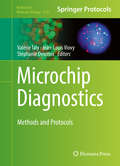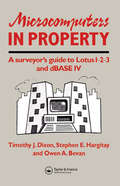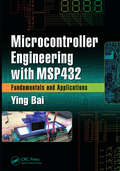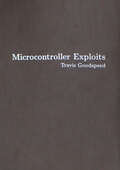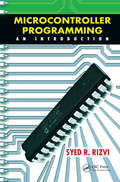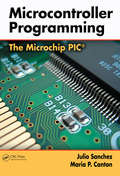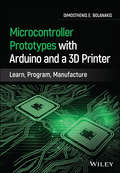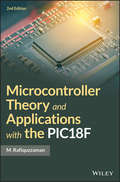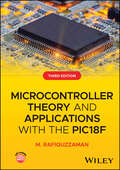- Table View
- List View
Microbiology of Well Biofouling (Sustainable Water Well Ser. #3)
by D. Roy Cullimore"The third book in the Sustainable Well Series, Microbiology of Well Biofouling, is the second edition of Practical Manual of Groundwater Microbiology. It is concerned with solving production problems in all types of wells.See what's new in the new edition:Addresses deleterious events in all types of wells in greater detailDiscusses the generation of mass which interferes with the physical functioning of a wellCovers the major innovations in the fieldIncludes more field applicable materialCompletely revised and updated
Microbiology-2.0 Update for a Sustainable Future
by Akarsh Verma Juhi GuptaThis book demonstrates the extremely fascinating and interdisciplinary microbial domain. It helps in discovering the latest advances in microbiology and learns how they can help shape a more sustainable future for our planet. This comprehensive guide covers the latest breakthroughs in microbiology research and their practical applications in fields such as ecology, agriculture, biotechnology, and environmental science. Furthermore, the readers explore the cutting-edge technologies and methodologies that are driving the next generation of microbiology research. With expert insights from the leading microbiologists, this book is an essential resource for anyone interested in understanding the role of microbes in our world and harnessing their power for a better tomorrow.
Microbiome Engineering: The New Dimension of Biotechnology
by Nimmy Srivastava, Salam A. Ibrahim and Mohamed Hussein Arbab NasrThis reference book compiles the latest techniques and applications of microbiome engineering. Microbial communities interact dynamically with their hosts, creating a considerable impact on the host and their ecosystem. This book introduces readers to microbiomes and microbiome engineering. It covers topics like omics tools in microbial research, strategies to engineer human microbiomes, the application of synthetic biology to build smart microbes, and the future of microbiome engineering. It includes the application of microbiome engineering in improving human health, livestock, and agricultural productivity. The book is intended for researchers and students in the fields of microbiology and biotechnology.
Microbiome and Plant Nutrition: A Roadmap Towards Sustainable Agriculture
by Upendra Kumar Sangita Mohanty Kambaska Kumar Behera Megha Kaviraj Rajeev PadbhushanThe book titled “Microbiome and Plant Nutrition꞉ A Roadmap Towards Sustainable Agriculture” is expected to direct many emerging research pathways needed at local and global levels for sustainable agricultural package and practices. This volume incorporates thirteen seminal chapters on issue based research and their practical applications covering latest information and progress in different areas of microbial supplemented crop nutrition for sustainable agriculture. The book highlights the frontier issues and applications of plant‑microbe interaction in crop nutritional strategy with topics like System biology of plant microbe interaction, Plant growth‑promoting rhizobacteria꞉ a context for sustainable agriculture, Plant growth‑promoting endophytes꞉ a context for sustainable agriculture, The role of the mycorrhiza in nutrient uptake, Plant nitrogen, phosphorus and sulphur nutrition꞉ a microbial perspective, Carbon and nitrogen turnover in soils and plant rhizo‑deposition, Root exudates꞉ a link to plant‑microbe nutritional interactions and insight into the metabolic and nutrition network pathway of plant‑microbe interaction, Commercialization perspective of bio‑stimulants for sustainable agriculture, Interconnection of plants with microbiomes in changing climate꞉ a functional extension of the host and heavy metal dynamics in rice soil꞉ an alleviation through microbial intervention approach. This book will be very useful for the scholars, biotechnologists, agricultural scientists, plant nutritionists, researchers, teachers and students in the emerging field of soil‑microbiome and plant nutrition dynamics in the resilient climatic agriculture era.
Microbiome in Plant Health and Disease: Challenges and Opportunities
by Manoj Kumar Devendra K. Choudhary Ram Prasad Vivek KumarThe book discusses the complex interactions between plants and their associated microbial communities. It also elucidates the ways in which these microbiomes are connected with the plant system, and how they affect plant health. The different chapters describe how microbiomes affect plants with regard to immunity, disease conditions, stress management and productivity. In addition, the book describes how an ‘additional plant genome’ functions as a whole organ system of the host, and how it presents both challenges and opportunities for the plant system. Moreover, the book includes a dedicated section on using omics tools to understand these interactions, and on exploiting them to their full potential.
Microbiome-Gut-Brain Axis: Implications on Health
by R. Z. Sayyed Mahejibin KhanThe book highlights the importance of prebiotics, probiotics and synbiotics in the signalling mechanism between gut microbiota and brain, also referred to as the gut-brain axis. A stable gut microbiota is essential for normal gut physiology and overall health, since it assists in proper signalling along the brain–gut axis. The book describes how the cross talks between gut microbiota and brain, not only regulate gastro-intestinal functions but also ensure proper functioning of cognitive behaviour and immunological functions. The various chapters describe probiotic microorganisms that colonize gastrointestinal tract and provide an array of health benefits to the host. It further elaborates about certain non-digestible oligosaccharides (prebiotics) are easily fermented by specialist microbes in the gut, to produce health-promoting metabolites and inhibit the growth of pathogenic bacteria. This book is useful for students, researchers and scientists in the field of microbiology, food science and nutrition. It is also meant for industry experts involved in developing nutraceuticals.
Microbiomes and Emerging Applications (Multidisciplinary Applications and Advances in Biotechnology)
by Nwadiuto Diuto EsiobuThis book covers a range of important topics and recent advances in metagenomics, microbiomes and their emerging applications, including microbiota transplantation and its health implications. It also discusses microbiome composition and development in humans. The contributors of this volume provide detailed information on prebiotics and probiotics for enhanced human health. They also introduce microbiomes as the next frontiers in medicine, agriculture, industry and environment. A chapter is presented that discusses probiotic research studies in Nigeria and Canada that led to the discovery of Lactobacillus pentosus KCA1. The book contains timely knowledge and will be useful reference material for scientists and researchers working in the fields of food and agricultural biotechnology, biopharmaceuticals and medical biotechnology, fermentation technology, environmental biotechnology, microbiomes and microbial biotechnology and health care. Emphasizes recent advances in metagenomics and microbiomes and their emerging applications in medicine, agriculture, industry and environment Provides detailed information on prebiotics and probiotics for enhanced human health Introduces microbiomes as the next frontiers in medicine, agriculture, industry and environment Reviews microbiota transplantation, health implications and the way forward Discusses microbiome-epigenetic-host interactions essential for the physiological functions of the body in health and disease Nwadiuto (Diuto) Esiobu, Ph.D., is a Professor of Microbiology and Biotechnology at Florida Atlantic University, Boca Raton, FL, USA, and the President and Founder, of Applied Biotech Inc. and ABINL. James Chukwuma Ogbonna, Ph.D., is a Professor of Microbiology and Biotechnology, and Director, National Biotechnology Development Agency, South East Zonal Biotechnology Centre, University of Nigeria, Nsukka, Nigeria. Charles Oluwaseun Adetunji, Ph.D., is an Associate Professor of Microbiology and Biotechnology, and Director of Intellectual Property and Technology Transfer, Edo State University Uzairue, Nigeria. Olawole O. Obembe, Ph.D., is a Professor of Plant Biotechnology and UNESCO Chair, Plant Biotechnology, Covenant University, Ota, Nigeria. Ifeoma Maureen Ezeonu, Ph.D., is a Professor of Medical Microbiology and Molecular Genetics in the Department of Microbiology, University of Nigeria, Nsukka, Nigeria. Abdulrazak B. Ibrahim, Ph.D., is a Capacity Development Expert at the Forum for Agricultural Research in Africa (FARA) and Associate Professor of Biochemistry, Ahmadu Bello University, Zaria, Nigeria. Benjamin Ewa Ubi, Ph.D., is a Professor of Plant Breeding and Biotechnology and Director, Biotechnology Research and Development Centre, Ebonyi State University, Abakaliki, Nigeria..
Microbiomes and the Global Climate Change
by Abdul Malik Showkat Ahmad LoneThis book covers the contemporary environmental issues faced by life on the planet and the role planetary microbiomes play in such issues. Providing insights on the net favorable and adverse effect of microbial processes, this volume covers both the spontaneous and anthropocentric events that impact climate change and life on the planet. The book describes the ecological significance of microbiomes associated with the kingdoms Plantae and Animalia with respect to climate change, natural and anthropogenic causes of climate change, microbial interactions in nature, planetary microbiomes and food security, climate change in relation to disease epidemiology and human health and engineering microorganisms to mitigate the consequences of climate change. The individual chapters in the intended book provide both theoretical and practical exposure to the current issues and future challenges of climate change in relation to the microbiomes. This collection should serve as ready reference to the researchers working in the area to reshape their future research in addressing the challenges of global climate change.
Microbiomes for the Management of Agricultural Sustainability
by Rouf Ahmad Bhat Mohammad Aneesul Mehmood Gowhar Hamid DarThis volume discusses innovative advancements in soil and crop microbiome technology and methods to support agricultural sustainability and reduce soil degradation. As climate change impacts agricultural productivity and soil health in impacted regions throughout the world, potential alternatives to find balance between soil health and crop yield are increasingly needed. Therefore, this book provides a timely, global perspective with a collection of expert authors to address how microbiomes can be used to achieve agricultural sustainability in threatened and degraded areas, while also covering related matters including soil health, pest management, waste disposal, environmental contamination, biofertilizer production, composting, and microbial engineering. The book is meant to serve as a reference for agriculturalists, environmentalists, graduate and post-graduate students, researchers, and professors of sustainability and agricultural management.
Microbiota and Biofertilizers, Vol 2: Ecofriendly Tools for Reclamation of Degraded Soil Environs
by Khalid Rehman Hakeem Rouf Ahmad Bhat Mohammad Aneesul Mehmood Gowhar Hamid DarThe dependence of present farming on artificial input of “chemical fertilizers” has caused numerous ecological tribulations associated with global warming and soil contamination. Moreover, there is an essential requirement for realistic agricultural practices on a comprehensive level. Accordingly, biofertilizers including microbes have been recommended as feasible environmentally sound solutions for agricultural practices which not only are natural, and cost-effective but also preserve soil environs and important biota of agricultural land. In addition, it enhances the nutrient quantity of soils organically. Microbial biofertilizers promote plant growth by escalating proficient absorption of nutrients for the plants and by providing an excellent disease-fighting mechanism.Agriculture, the backbone of human sustenance, has been put under tremendous pressure by the ever-increasing human population. Although various modern agro-techniques boosted agricultural production, the excessive use of synthetic fertilizers, pesticides and herbicides have proven extremely detrimental to agriculture as well as to the environment in which it is carried out. Besides this some faulty agricultural practices like monoculture and defective irrigation, further complicate the scenario by eliminating biodiversity, increasing the efflux of nutrients into the water bodies, the formation of algal blooms, eutrophication, damaging the water quality and lowering fish stocks. Biofertilizers are the organic compounds applied to crops for their sustainable growth and the sustainability of the environment as the microbiota associated with biofertilizers interact with the soil, roots and seeds to enhance soil fertility. Application of biofertilizers results in the increased mineral and water uptake, root development, vegetative growth and nitrogen fixation besides liberating growth-promoting substances and minerals that help the maintenance of soil fertility. They further act as antagonists and play a pivotal role in neutralising soil-borne plant pathogens and thus, help in the bio-control of diseases. Application of biofertilizers instead of synthetic fertilizers could be a promising technique to raise agricultural productivity without degrading environmental quality. The present book focuses on the latest research approaches and updates from the microbiota and their applications in the agriculture industry. We believe this book addresses various challenges and shed lights on the possible future of the sustainable agricultural system.
Microbiota and Biofertilizers: A Sustainable Continuum for Plant and Soil Health
by Khalid Rehman Hakeem Rouf Ahmad Bhat Mohammad Aneesul Mehmood Gowhar Hamid DarAn increasing population has put tremendous pressure on agricultural productivity to fulfill the demands of human consumption. Numerous agricultural activities and techniques have been developed to raise annual crop production globally. While agriculture has succeeded in enhancing the yearly crop productivity, this achievement is at the cost of environmental degradation by applying synthetic persistent substances, such as industrial fertilizers, pesticides, herbicides, etc. Chemical fertilizers are nearly as destructive as they are productive, causing monocultures and consequences associated with elimination of diversity, nutrient pollution as evidenced by algae blooms, eutrophication, water quality issues, lower oxygen levels and dangers to fish stocks. Therefore, the scientific approach to maintain sustainable fertility in soil and plants is to switch over to biofertilisers.Biofertilisers are compounds of organic matter that are applied to crops for growth and health. Their constituent micro-organisms interact in an ecofriendly manner with the soil, root and seeds of plants, promoting the growth of micro-flora that enhances soil fertility. They are known to play a number of vital roles in soil fertility, crop productivity and production in agriculture. Application of biofertilisers results in increased mineral and water uptake, root development, vegetative growth and nitrogen fixation. They liberate growth promoting substances and vitamins and help to maintain soil fertility. They act as antagonists and play a pivotal role in neutralising the soil borne plant pathogens, thereby assisting in the bio-control of diseases. Application of biofertilisers in lieu of synthetic fertilizers could be the promising technique to raise agricultural productivity without degrading the environmental quality. The present book focuses on the latest research approaches and updates from the microbiota ecosystem and their applications in agriculture industry. It also highlights the great potential and possible future of action of microbiota in the development of sustainable agricultural systems.
Microbites: Riveting Reads for Curious Kids (DK Bitesize Readers)
by DKThis nonfiction chapter book about flight is chock-full of bite-size facts, black-and-white photographs, and CGI illustrations to dazzle and engage even the most reluctant reader.The astonishing science of airplanes, helicopters, and other flying contraptions might seem beyond reach, but Microbites: Flight breaks it all down into manageable chunks of information on need-to-know topics like how planes fly, history's largest airships, early spacecraft, and other feats of flight engineering. Illustrations and photographs accent nearly every page, while highlighted text calls out important takeaways about each chapter topic, revealing new details about what keeps these marvelous machines aloft. For further learning, kids can turn to the book's eight-page reference section, where they'll find a glossary, a historical timeline, and a list of the most awe-inspiring aviators. Whether they're new to flight science or seasoned pros, readers will find plenty of fascinating facts to chew on in Microbites: Flight.DK's Microbites series takes daunting nonfiction topics and transforms them into easy-to-digest, mini-guides on kids' favorite subjects from history, science, and the natural world. Packed with eye-catching illustrations, detailed photographs, and the latest scientific research on everything from dinosaurs to mummies, the Microbites series encourages a healthy reading appetite in kids ages 8 through 12, and will leave them hungry to learn more.
Microbubbles: Engineering Aspects and Industrial Applications
by Snigdha KhuntiaComprehensive resource exploring the basic principles of microbubbles including modeling and simulation, as well as applications across various industrial processes Featuring in-depth case studies, Microbubbles delves into the science and engineering behind microbubbles, their unique properties, and the state-of-the-art techniques being utilized to unlock their full potential, with insight into their various industrial applications, such as in computational fluid dynamics (CFD) modeling, as well as statistical and numerical analyses of lab-scale and pilot-scale operations. Written by a highly qualified author with significant research contributions to the field, this comprehensive resource discusses sample topics including: Fundamental concepts of mass transfer as well as reaction engineering and process design of microbubble-based systemsDifferent types of microbubbles, including ozone, N2, air, and O2, and the scope of microbubble industrial scalability, with information on cost and energy estimationIntrinsic concepts of chemical and environmental engineering related to microbubbles and recent developments in the simulation of microbubble systemsLatest breakthroughs in microbubble technology, encompassing their use in nanotechnology, pollution control and treatment, and environmental remediation This book is an essential reference on the subject for researchers at the postgraduate, PhD, and postdoctoral levels, along with engineers and chemists working with water and wastewater treatment technology. Understanding the basics of mass transfer and solid operations is a prerequisite to reading.
Microcavity Semiconductor Lasers: Principles, Design, and Applications
by Yong-zhen Huang Yue-de YangMicrocavity Semiconductor Lasers Explore this thorough overview of integrable microcavity semiconductor lasers and their applications from two leading voices in the fieldAttracting a great deal of attention over the last decades for their promising applications in photonic integration and optical interconnects, microcavity semiconductor lasers continue to develop via advances in fundamental physics, theoretical analysis, and numerical simulations. In a new work that will be of interest to researchers and practitioners alike, Microcavity Semiconductor Lasers: Principles, Design, and Applications delivers an application-oriented and highly relevant exploration of the theory, fabrication, and applications of these practical devices.The book focuses on unidirectional emission microcavity lasers for photonic integrated circuits, including polygonal microresonators, microdisk, and microring lasers. After an introductory overview of optical microcavities for microlasers and detailed information of the lasers themselves, including mode structure control and characteristics, and lasing properties, the distinguished authors discuss fabrication and applications of different microcavity lasers. Prospects for future research and potential new applications round out the book.Readers will also benefit from the inclusion of:A thorough introduction to multilayer optical waveguides, the FDTD Method, and Padé Approximation, and deformed, chaos, and unidirectional emission microdisk lasersAn exploration of mode analysis for triangle and square microresonators similar as FP CavityPractical discussions of mode analysis and control for deformed square microlasersAn examination of hexagonal microcavity lasers and polygonal microcavities, along with vertical radiation loss for 3D microcavitiesPerfect for laser specialists, semiconductor physicists, and solid-state physicists, Microcavity Semiconductor Lasers: Principles, Design, and Applications will also earn a place in the libraries of materials scientists and professionals working in the semiconductor and optical industries seeking a one-stop reference for integrable microcavity semiconductor lasers.
Microcellular Injection Molding
by Jingyi Xu Lih-Sheng Tom TurngThis book presents the most important aspects of microcellular injection molding with applications for science and industry. The book includes: experimental rheology and pressure-volume-temperature (PVT) data for different gas materials at real injection molding conditions, new mathematical models, micrographs of rheological and thermodynamic phenomena, and the morphologies of microcellular foam made by injection molding. Further, the author proposes two stages of processing for microcellular injection molding, along with a methodology of systematic analysis for process optimization. This gives critical guidelines for quality and quantity analyses for processing and equipment design.
Microchemical Engineering in Practice
by Thomas DietrichMicrochemical Engineering in Practice provides the information chemists and engineers need to evaluate the use of microreactors, covering the technical, operational, and economic considerations for various applications. It explains the systems needed to use microreactors in production and presents examples of microreactor use in different chemistries, including larger scale production processes. There are guidelines on calculating the costs and the risks of production using continuous flow microreactors. Complete with case studies, this is an essential guide for chemists and engineers interested in investigating the advantages of chemical microreactors.
Microchip Diagnostics
by Valérie Taly Jean-Louis Viovy Stéphanie DescroixThis volume illustrates how microfluidic approaches can meet the requirement of clinical diagnosis based on molecular or cellular biomarkers. Microchip Diagnostics: Methods and Protocols is divided into four sections describing the business aspects of the microfluidic-based systems for diagnosis, demonstrating how versatile microfluidics can be regarding to protein bioassay integration, presenting microfluidic approaches for nucleic analysis based on mono or diphasic format, and highlighting recent contributions. Written in the highly successful Methods in Molecular Biology series format, chapters include introductions to their respective topics, lists of the necessary materials and reagents, step-by-step, readily reproducible laboratory protocols, and tips on troubleshooting and avoiding known pitfalls.
Microcomputers in Property: A surveyor's guide to Lotus 1-2-3 and dBASE IV
by O. Bevan T.J. Dixon S. HargitayThis handbook introduces surveyors to the use of microcomputers in the property industry using 'real-life' example applications with clear explanations, it will provide the surveyor with the knowledge and expertise to design spreadsheets and database management systems for use in a variety of general practice tasks from valuation to estate agency.
Microcontroller Engineering with MSP432: Fundamentals and Applications
by Ying BaiThis book aims to develop professional and practical microcontroller applications in the ARM-MDK environment with Texas Instruments MSP432P401R LaunchPad kits. It introduces ARM Cortex-M4 MCU by highlighting the most important elements, including: registers, pipelines, memory, and I/O ports. With the updated MSP432P401R Evaluation Board (EVB), MSP-EXP432P401R, this MCU provides various control functions with multiple peripherals to enable users to develop and build various modern control projects with rich control strategies. Micro-controller programming is approached with basic and straightforward programming codes to reduce learning curves, and furthermore to enable students to build embedded applications in more efficient and interesting ways. For authentic examples, 37 Class programming projects are built into the book that use MSP432P401R MCU. Additionally, approximately 40 Lab programming projects with MSP432P401R MCU are included to be assigned as homework.
Microcontroller Exploits
by Travis GoodspeedMicrocontroller Exploits is a deep dive into advanced hardware hacking with detailed examples of real-world techniques and a comprehensive survey of vulnerabilities.In this advanced guide to hardware hacking, you'll learn how to read the software out of single chip computers, especially when they are configured not to allow the firmware to be extracted. This book documents a very wide variety of microchip hacking techniques; it's not a beginner's first introduction.You'll start off by exploring detailed techniques for hacking real-world chips, such as how the STM32F0 allows for one word to be dumped after every reset. You'll see how the STM32F1&’s exception handling can slowly leak the firmware out over an hour, and how the Texas Instruments MSP430 firmware can be extracted by a camera flash.For each exploit, you'll learn how to reproduce the results, dumping a chip in your own lab.In the second half of the book you'll find an encyclopedic survey of vulnerabilities, indexed and cross referenced for use in practicing hardware security.
Microcontroller Programming: An Introduction
by Syed R. RizviMicrocontroller Programming: An Introduction is a comprehensive one-stop resource that covers the concepts, principles, solution development, and associated techniques involved in microcontroller-based systems. Focusing on the elements and features of the popular and powerful Motorola 68HC11 microcontroller IC as a representative example, this book
Microcontroller Programming: The Microchip PIC
by Julio Sanchez Maria P. CantonFrom cell phones and television remote controls to automobile engines and spacecraft, microcontrollers are everywhere. Programming these prolific devices is a much more involved and integrated task than it is for general-purpose microprocessors; microcontroller programmers must be fluent in application development, systems programming, and I/O operation as well as memory management and system timing. Using the popular and pervasive mid-range 8-bit Microchip PIC® as an archetype, Microcontroller Programming offers a self-contained presentation of the multidisciplinary tools needed to design and implement modern embedded systems and microcontrollers. The authors begin with basic electronics, number systems, and data concepts followed by digital logic, arithmetic, conversions, circuits, and circuit components to build a firm background in the computer science and electronics fundamentals involved in programming microcontrollers.For the remainder of the book, they focus on PIC architecture and programming tools and work systematically through programming various functions, modules, and devices. Helpful appendices supply the full mid-range PIC instruction set as well as additional programming solutions, a guide to resistor color codes, and a concise method for building custom circuit boards.Providing just the right mix of theory and practical guidance, Microcontroller Programming: The Microchip PIC® is the ideal tool for any amateur or professional designing and implementing stand-alone systems for a wide variety of applications.
Microcontroller Prototypes with Arduino and a 3D Printer: Learn, Program, Manufacture
by Dimosthenis E. BolanakisDiscover a complete treatment of microcomputer programming and application development with Arduino and 3D printers Microcontroller Prototypes with Arduino and a 3D Printer: Learn, Program, Manufacture delivers a comprehensive guide to learning microcontrollers that’s perfectly suited to educators, researchers, and manufacturers. The book provides readers with a seasoned expert’s perspective on the process of microcomputer programming and application development. Carefully designed and written example code and explanatory figures accompany the text, helping the reader fully understand and retain the concepts described within. The book focuses on demonstrating how to craft creative and innovative solutions in embedded systems design by providing practical and illustrative methods and examples. An accompanying website includes functioning and tested source code and learning exercises and the book relies on freeware development tools for the creation of firmware and software code, 3D printed enclosures, and debugging. It allows the reader to work with modern sensors and collect sensor data to a host PC for offline analysis. Readers will also benefit from the inclusion of: A thorough introduction to the art of embedded computers, including their interdisciplinarity, TPACK analysis, and the impact of microcontroller technology on the maker industry An exploration of embedded programming with Arduino, including number representation and special-function codes and C common language reference A discussion of hardware interfaces with the outside world, including digital pin interface, analog pin interface, UART serial interface, I2C, and SPI A treatment of sensors and data acquisition, including environmental measurements with Arduino Uno, orientation and motion detection with Teensy, gesture recognition with TinyZero, and color sensing with Micro:bit A variety of supplementary resources – including source codes and examples - hosted on an accompanying website to be maintained by the author: www.mikroct.com. Perfect for researchers and undergraduate students in electrical and electronic engineering or computer engineering, Microcontroller Prototypes with Arduino and a 3D Printer: Learn, Program, Manufacture will also earn a place in the libraries of hardware engineers, embedded system designers, system engineers, and electronic engineers.
Microcontroller Theory and Applications with the PIC18F
by M. RafiquzzamanA thorough revision that provides a clear understanding of the basic principles of microcontrollers using C programming and PIC18F assembly language This book presents the fundamental concepts of assembly language programming and interfacing techniques associated with typical microcontrollers. As part of the second edition's revisions, PIC18F assembly language and C programming are provided in separate sections so that these topics can be covered independent of each other if desired. This extensively updated edition includes a number of fundamental topics. Characteristics and principles common to typical microcontrollers are emphasized. Interfacing techniques associated with a basic microcontroller such as the PIC18F are demonstrated from chip level via examples using the simplest possible devices, such as switches, LEDs, Seven-Segment displays, and the hexadecimal keyboard. In addition, interfacing the PIC18F with other devices such as LCD displays, ADC, and DAC is also included. Furthermore, topics such as CCP (Capture, Compare, PWM) and Serial I/O using C along with simple examples are also provided. Microcontroller Theory and Applications with the PIC18F, 2nd Edition is a comprehensive and self-contained book that emphasizes characteristics and principles common to typical microcontrollers. In addition, the text: Includes increased coverage of C language programming with the PIC18F I/O and interfacing techniques Provides a more detailed explanation of PIC18F timers, PWM, and Serial I/O using C Illustrates C interfacing techniques through the use of numerous examples, most of which have been implemented successfully in the laboratory This new edition of Microcontroller Theory and Applications with the PIC18F is excellent as a text for undergraduate level students of electrical/computer engineering and computer science.
Microcontroller Theory and Applications with the PIC18F
by M. RafiquzzamanStraightforward and comprehensive textbook on programming and interfacing techniques for the PIC18F4321 microcontroller, supported by hundreds of illustrations throughout Microcontroller Theory and Applications with the PIC18F presents core information on the theory of microcontrollers and the fundamental concepts of assembly and C language programming and interfacing techniques associated with the Microchip's PIC18F4321 microcontroller. Characteristics and principles common to typical microcontrollers are emphasized, and basic microcontroller interfacing techniques are demonstrated via examples using the simplest possible devices such as switches, LEDs, Seven-Segment Displays, and the hexadecimal keyboard. In addition, interfacing the PIC18F with other devices such as LCD displays, ADC, DAC is also included. Furthermore, topics such as CCP (Capture, Compare, PWM) and Serial I/O using assembly and C languages along with simple examples are also provided. Information on the design of the PIC18F-based digital DC voltmeter and interfacing the PIC18F with PWM (Pulse Width Modulation) mode to a DC motor using both assembly and C languages is provided. Finally, PIC18F Serial I/O examples using both SPI and I2C modes are also included. All these examples are illustrated by means of successful implementations in the laboratory. Building on the success of previous editions, this Third Edition has been extensively revised to include enhanced clarity in each chapter and additional illustrations, end-of-chapter problems, and examples. Certain concepts such as stack, bank-memory, programmed I/O, interrupt I/O, and CCP have been rewritten to better relate them to the PIC18F. Details on the MPLABX assembler/debugger and XC8 C-Compiler are now included as well. Microcontroller Theory and Applications with the PIC18F includes information on: Microcontroller data types, unsigned and signed binary numbers and ASCII code, unpacked and packed binary-coded-decimal numbers, and the evolution of the microcontroller Provides guidelines on how to choose the right language (Assembly or C ) for specific applications PIC18F architecture and addressing modes, covering register architecture, memory organization, and program and data memories Programming PIC18F programmed I/O, interrupt I/O, and interfacing PIC18F4321 to a hexadecimal keyboard and a seven-segment display ADC, DAC, CCP, and Serial I/O interfacing techniques Microcontroller Theory and Applications with the PIC18F is an essential learning resource for students in related programs of study seeking information on basic concepts relating to a specific and simple microcontroller such as the PIC18F in an organized and simplified manner.
